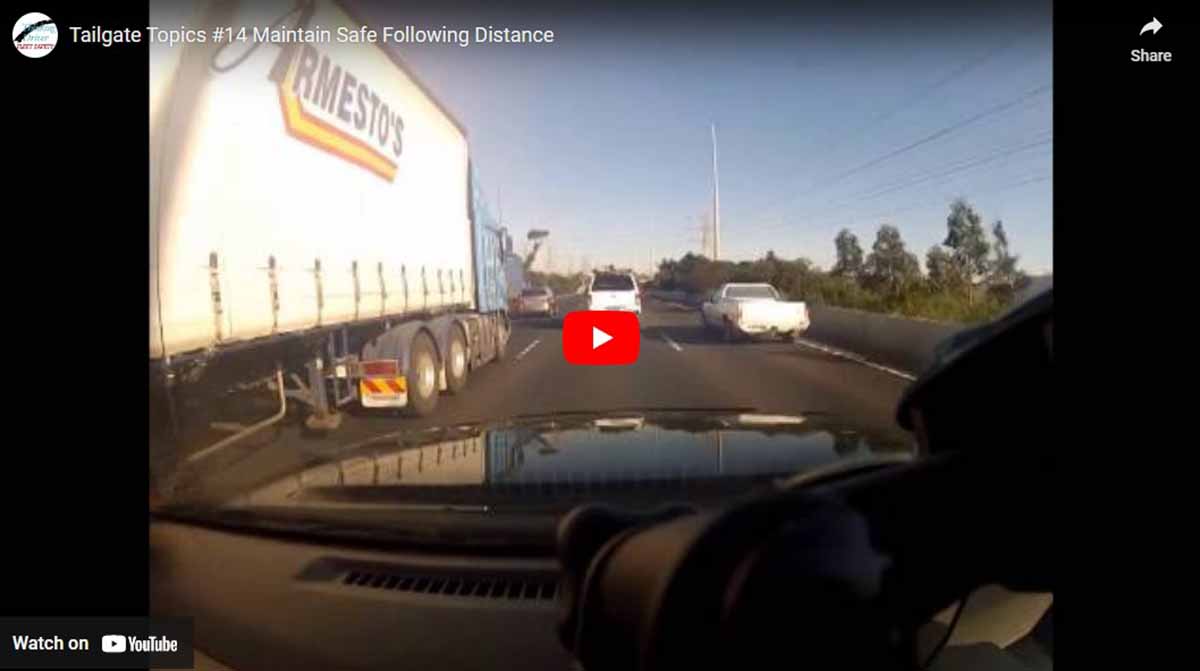Safety Meeting Planner & Agenda
Check Your Following Distance!
Meeting Leader:
- Prepare in advance to make this meeting effective.
- Print and read over this entire agenda.
- Think about how you want to lead the meeting.
- Is there anything that is specific to your company or operation that you can include to personalize the information?
- Review the video for this session.
- Save the link to the video in your ‘Favourites’ folder on your browser for easy access.
- Open and then minimize the viewer just before the meeting to make the video introduction smooth.
Start Your Meeting!
Opening Statement:
Pretty much all rear end collisions can be prevented by maintaining a safe following distance from the vehicle in front of you.
Questions for this Meeting:
Q: What is a safe following distance and how can you check that you are leaving enough room?
Answer:
The only way to accurately check your following distance is by using the ‘time interval formula’ which works by picking a fixed landmark like a sign or some other stationary object and counting seconds as the vehicle in front of you passes it. The number of seconds that you count is your time interval.
Under the best conditions, the minimum number of seconds needs to be 2 and more as conditions change or deteriorate.
Q: Why is this so important?
Answer:
Stopping distance is a combination of reaction distance and braking distance. Reaction distance is the distance that your vehicle travels from the time you see a reason to apply brakes to when you actually move your foot to the brake pedal and begin to slow down. If you are too close to the vehicle in front, you will hit them NO MATTER HOW GOOD A DRIVER YOU ARE because you can only get to the brake as fast as a human can move and by the time you get there, if the guy in front is already braking hard, you don’t stand a chance.
Q: What are some conditions that would require an increase in following distance?
Answer:
- Weather condition: like rain, snow or other weather problems.
- Road condition: such as gravel or broken pavement or other problems with the road. In slippery conditions, such as snow, ice or wet pavement, much more space is advisable.
- Lighting condition: at night or if you are looking into reflected sun or glare, you need more space because you will not see things as easily.
- Traffic condition: as traffic gets heavier, you need to stay aware of much more than in light traffic, this occupies your attention so more space in front buys you more time to react.
- YOUR condition: if you are tired or otherwise not 100%, leave more space because your reactions may not be as quick.
Introduce the Video:
Spencer McDonald discusses how to reduce the chances of a rear end collision and notes multiple additional benefits of maintaining a safe following distance. Time interval formula is discussed and demonstrated and the benefits of enhanced vision, when keeping a good following distance, are also discussed.
Practical Challenge:
Today as you drive, count your time interval and see just how much space you are actually leaving. Make adjustments as necessary and practise re-adjusting pretty soon, you will be able to judge the distance accurately and will only need to check once in a while!
Let’s all have a safe day!









